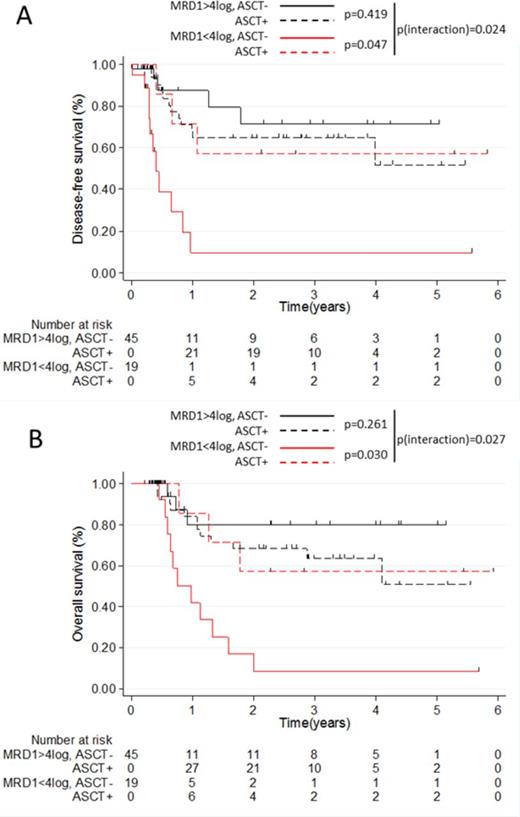Abstract

Introduction
Therapy decision in young adults with acute myeloid leukemia (AML) is mostly guided by pre-therapeutic risk assessment based on cytogenetical and molecular characterizations. Mutations in the nucleophosmin 1 (NPM1 m) gene represent one of the most common gene mutations, found in around one third of AML and associated with normal karyotype in 85% of cases. Because of their homogeneous mutation pattern and their clonal stability, NPM1 mutations are an effective tool for monitoring MRD. The aim of this study was to assess the prognostic impact of post-induction NPM1 MRD in homogeneously treated patients and to address the question of whether NPM1 MRD may be used as a predictive factor of allogeneic stem cell transplantation (SCT) benefit in this subgroup of patients.
Materiel and methods
Among 196 NPM1 m patients treated in the ALFA-0702 trial, 172 achieved complete remission (CR). A MRD was available in 152 patients, on peripheral blood (PB) in 135 patients and on bone marrow (BM) in 135 patients. MRD levels were reported as the normalized values of NPM1 m copy number/ABL copy number x 100 (%). Patients were also screened for FLT3-TKD, FLT3-ITD, CEBPA, DMT3A, IDH1, IDH2, WT1 and TET2 mutations. Patients that did not belong to ELN-favorable group were eligible for allogeneic SCT (N=71).
Results
The median follow-up was 3.5 years (95%CI: 3.1-3.9). The karyotype was normal in 122 patients (80.3%), and a FLT3-ITD was found in 59/150 (39.3%) with a median FLT3-ITD allelic ratio of 0.385 (range: 0.02-8.0). Fifty out of the 71 patients eligible for SCT were allografted in first CR. The 3-year CIR and OS censored at SCT were 29.3% (95%CI: 21.5-39.4) and 78.6% (95%CI: 69.3-85.5) respectively.
At diagnosis, NPM1 baseline levels did not differ between PB and BM (p=.20). However, after induction, the median MRD log reduction was 4.5 in PB (range: 1.7-5.8) and 3.8 in BM (range: 0.01-5.5) (p<.0001). We focused here on the value of PB-MRD log reduction.
Patients with a high WBC (>50 G/L) or FLT3-ITD had higher NPM1 baseline but also PB-MRD levels. However, no correlation between PB-MRD log reduction and age, WBC, karyotype, or any of the gene mutations was observed.
Patients who did not achieve a 4-log reduction in NPM1 PB-MRD were exposed to a higher risk of relapse and had a shorter survival (3-year CIR censored at ASCT: 65.8% vs. 20.5%, SHR 5.83, 95%CI: 2.78-12.23, p<.001; 3-year OS censored at SCT: 92.3% 40.8%, HR 10.99, 95%CI: 3.97-30.39, p<.001). In multivariable analysis of CIR and OS censored at ASCT, abnormal karyotype, FLT3-ITD, and PB-MRD reduction < 4 log were significantly associated with a higher risk of event.
Among the 59 patients with FLT3-ITD, a PB-MRD reduction < 4 log was also predictive of a higher risk of relapse and a shorter survival (SHR 3.74, 95%CI: 1.47-9.53, p=.006; HR 3.26, 95%CI: 1.43-7.44, p=.005) along with age, logWBC, and FLT3-ITD allelic ratio. In multivariable analysis of CIR and OS, only age, logWBC, and PB-MRD reduction < 4 log were significantly associated with a higher risk of relapse or death.
Considering allogeneic SCT as a time-dependent variable, DFS but also OS were significantly improved by SCT in non-favorable ELN patients with PB-MRD reduction <4 log (DFS, HR 0.25, 95%CI: 0.06-0.98, p=.047; OS, HR 0.25, 95%CI: 0.06-0.98, p=.047). This benefit was not observed in patients with a favorable PB-MRD response (DFS, HR 1.62, 95%CI: 0.05-5.17, p=.419; OS, HR 2.11, 95%CI 0.57-7.71, p=.261) with a significant interaction between SCT effect and PB-MRD log reduction (DFS, p=.024; OS, p=.027).
Conclusion
Our study supports the prognostic significance of early NPM1 PB-MRD, independently of cytogenetical and molecular context. Moreover, NPM1 PB-MRD may be used as a predictive factor of allogeneic SCT benefit in non-favorable ELN population.
DFS (A) and OS (B) according to PB-MRD log reduction and post-remission therapy (SCT) in ELN non-favorable patients (Simon Makuch plots).
DFS (A) and OS (B) according to PB-MRD log reduction and post-remission therapy (SCT) in ELN non-favorable patients (Simon Makuch plots).
De Botton:Agios Pharmaceuticals: Research Funding. Dombret:Amgen: Honoraria, Membership on an entity's Board of Directors or advisory committees, Research Funding.
Author notes
Asterisk with author names denotes non-ASH members.

This icon denotes a clinically relevant abstract


This feature is available to Subscribers Only
Sign In or Create an Account Close Modal